15 Full-Sun Annuals That Will Add Beautiful Color To Your Garden All Summer Long
Soak up the summer sun with vibrant blooms that just don’t quit.
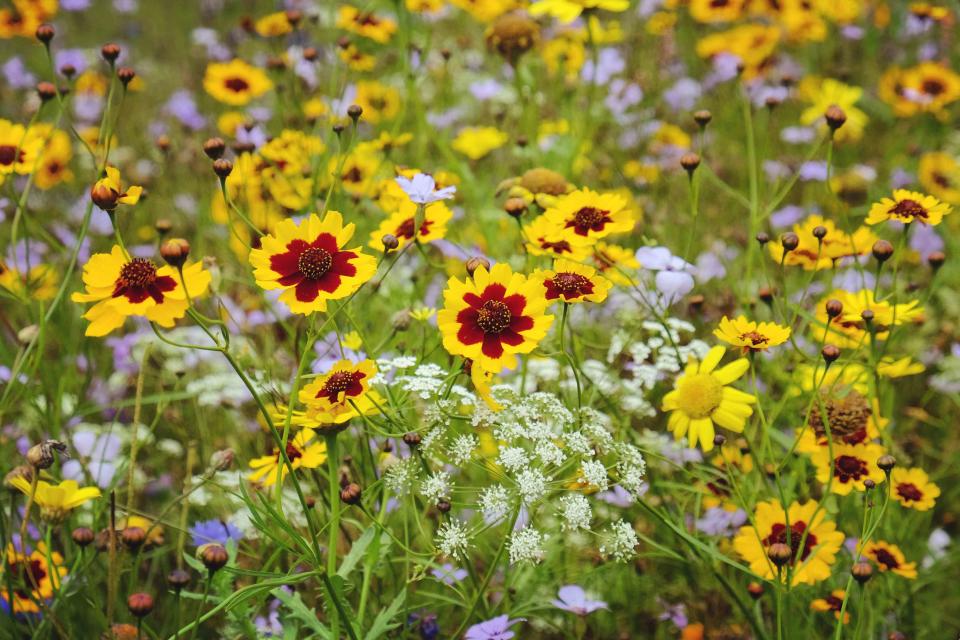
Getty Images
Annuals make gardening easy. They provide instant gratification, filling in quickly and blooming with abandon all season long. Annuals are inexpensive, allowing for endless experimentation in the garden from year to year and season to season. They are perfect for containers or hanging baskets, and for filling holes in the garden. Just like other plants in the garden, annuals and tender perennials vary in how much sunlight they need to thrive. We’ve rounded up fifteen gorgeous annuals that stand up to full sun in hot Southern gardens.
Some bedding plants sold as "annuals" are actually tender perennials, but due to their sensitivity to cold temperatures, they are commonly treated as annuals. This is particularly true in cooler climates. Gardeners in frost free areas of the Deep South may be able to carry some of the plants on this list over from one year to the next.
Related: 10 Fast-Growing Perennials That Will Fill Your Garden In A Flash
Trailing Petunia
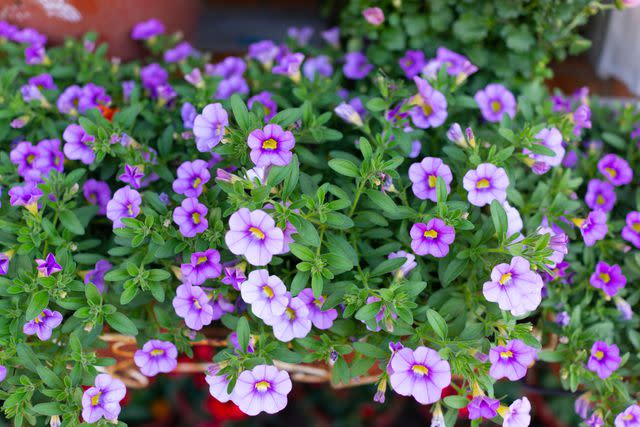
Getty Images
Botanical Name: Calibrachoa hybrids
Sun Exposure: Full Sun to Part Shade
Soil Type: Moist, Well-draining, Rich
Soil pH: Acidic (5.0-6.5)
With a trailing habit and non-stop flowering through the heat of summer, trailing petunia, also called calibrachoa, is a go-to for containers, hanging baskets, and border plantings. Hundreds of petunia-like blooms cover plants spring through frost, without the need for deadheading. This tough annual is available in a rainbow of flower colors, including solid and bi-color blooms. Though commonly sold and grown as an annual, trailing petunia is hardy in frost-free areas.
Brazilian Dwarf Morning-glory
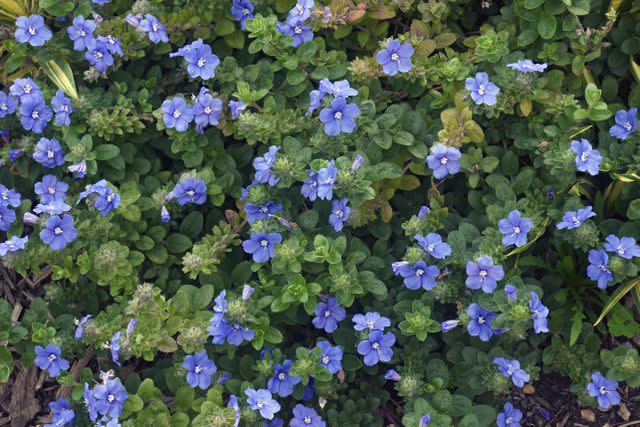
Getty Images
Botanical Name: Evolvulus glomeratus
Sun Exposure: Full Sun
Soil Type: Well-draining, Rich
Soil pH: Mildly Acidic to Neutral (6.0-7.2)
With brilliant, true-blue flowers and fuzzy silver-green foliage, this easy-to-grow annual makes a stunning groundcover or container planting in hard to plant areas. Dwarf Morning-glory is drought tolerant once established and unbothered by pests. With a somewhat sprawling habit, this plant looks lovely spilling over the edges of containers or stone walls.
Blanket Flower
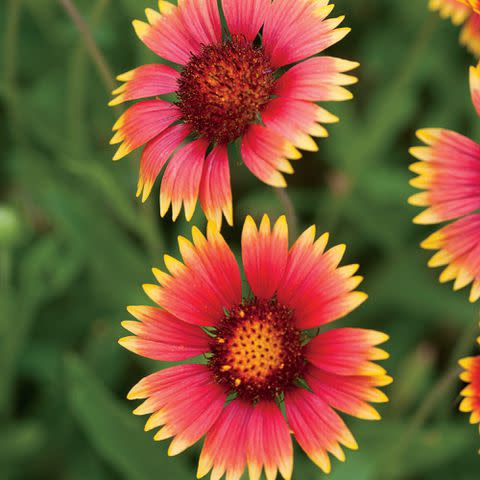
Botanical Name: Gaillardia pulchella
Sun Exposure: Full Sun
Soil Type: Dry to Medium, Well-draining, Average Fertility
Soil pH: Mildly Acidic to Slightly Alkaline (6.0-8.0)
This cheerful native wildflower brings vibrant color to the garden with red blooms fringed in yellow. Flowering late spring through fall, blanket flower is a butterfly favorite. Finches and other songbirds feast on the seedheads left to overwinter. Heat, drought, and salt tolerant, this tough plant adapts to a variety of planting sites and soil conditions.
Globe Amaranth 'Fireworks'
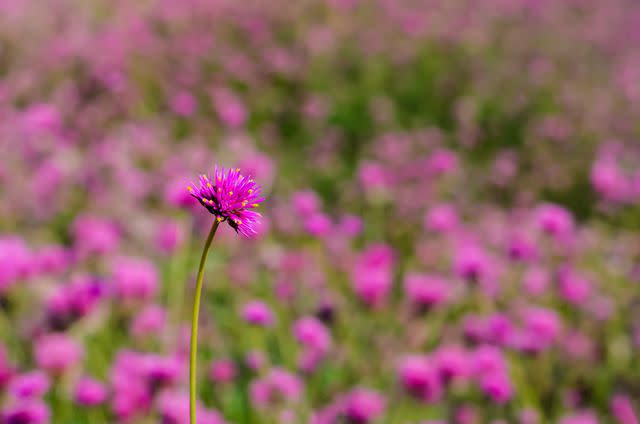
Getty Images
Botanical Name: Gomphrena globose 'Fireworks'
Sun Exposure: Full Sun
Soil Type: Dry to Medium, Well-draining, Average Fertility
Soil pH: Mildly Acidic to Slightly Alkaline (6.0-8.0)
This heat-loving globe amaranth stands apart from other varieties thanks to its tall flower stalks boasting masses of magenta pink blooms. Tiny golden flowers tip the spherical flower clusters like sparks, giving the plant its common name. Flowering late spring through frost, 'Fireworks' makes a unique cut flower, both fresh and dried.
South African Foxglove
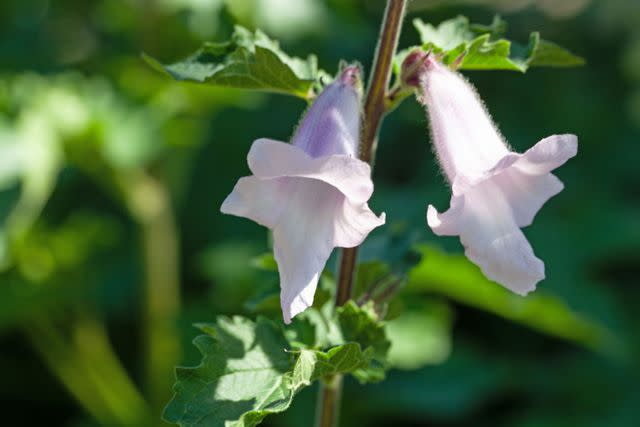
Getty Images
Botanical Name: Ceratotheca triloba
Sun Exposure: Full Sun
Soil Type: Well-draining, Rich
Soil pH: Acidic (5.0-6.0)
Despite its common name, South African foxglove belongs to the snapdragon family (Scrophulaiaceae), though its drooping, lavender flowers resemble those of its namesake. Blooming late spring through frost, plants produce huge, 4-inch tubular blooms beloved by hummingbirds, butterflies, and bumblebees. Plant this lofty (60 inches) annual toward the back of flower beds where its tall spikes can peak out among other blooms.
Angelonia
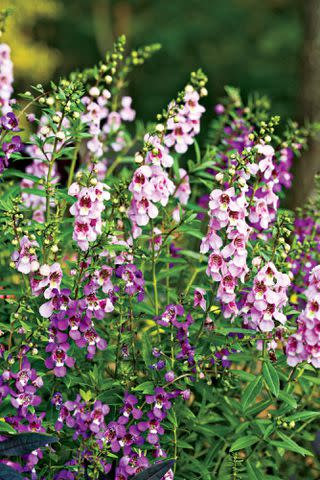
Botanical Name: Angelonia angustifolia
Sun Exposure: Full Sun
Soil Type: Moist, Well-draining, Rich
Soil pH: Mildly Acidic (5.8-6.8)
This relative newcomer to the garden trade quickly captured gardeners’ hearts with its upright spires of violet, mauve, pink, or white blooms. Plants bloom all summer without deadheading and tolerate high heat. Plant in full sun and provide good air circulation around plants to avoid powdery mildew. Angelonia is a tender perennial and can be overwintered outdoors in frost-free areas.
Egyptian Star Flower
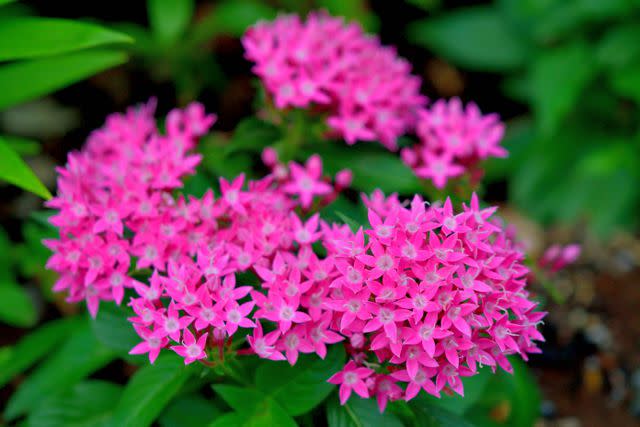
Getty Images
Botanical Name: Pentas lanceolata
Sun Exposure: Full Sun to Part Shade
Soil Type: Medium Moisture, Well-draining, Average Fertility
Soil pH: Mildly Acidic to Neutral (6.0-7.0)
With dense clusters of star-shaped flowers, pentas shines in gardens and containers. Blooming in vibrant red, violet, pink, and white all season long, this sturdy plant stands up to heat and humidity and has good drought tolerance. Hummingbirds are drawn to red varieties, and butterflies swarm the long-lasting blooms.
Mexican Zinnia
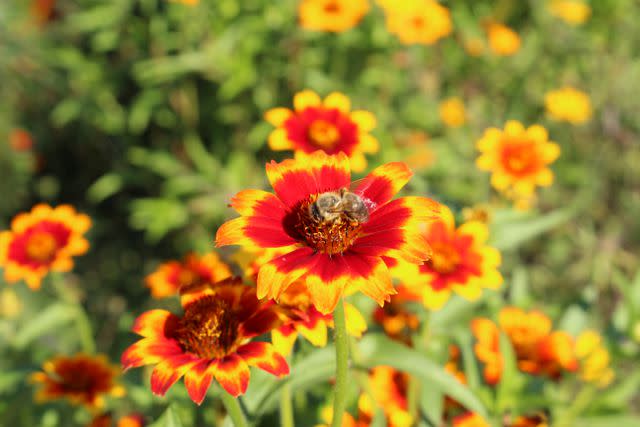
Getty Images
Botanical Name: Zinnia haageana
Sun Exposure: Full Sun to Part Shade
Soil Type: Medium to Dry, Well-draining, Rich
Soil pH: Mildly Acidic to Neutral (6.0-7.5)
The cheery blooms of Mexican zinnia are sure to brighten containers and planting beds. With a single or double layer of orange, yellow, red, burgundy, or bi-colored ray petals surrounding the tiny disc flowers, Mexican zinnias are frequented by bees, butterflies, and other pollinators. Plants have narrow foliage and are very tolerant of heat and drought. Mexican zinnia makes an excellent cut flower.
Spider Flower
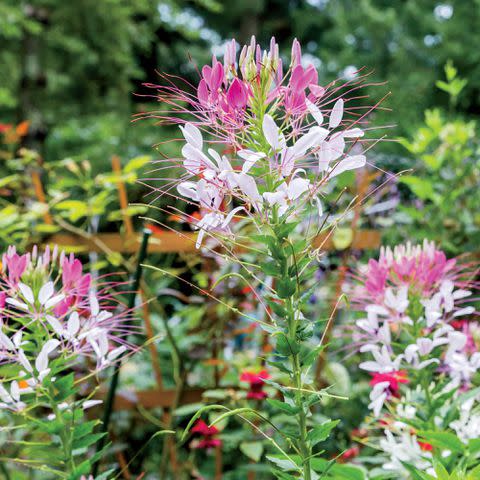
Botanical Name: Cleome houtteana
Sun Exposure: Full Sun to Part Shade
Soil Type: Dry to Medium, Well-draining, Average Fertility
Soil pH: Mildly Acidic to Neutral (6.0-7.0)
With wispy flower clusters standing high above the ground, spider flowers add texture and movement to flower beds. Gorgeous palmate foliage and non-stop blooms make for a stunning display that attracts hummingbirds, butterflies, and birds. Plants reseed freely in the garden but are not considered invasive. Spider flowers tolerate a wide range of growing conditions and soils.
Firecracker Plant
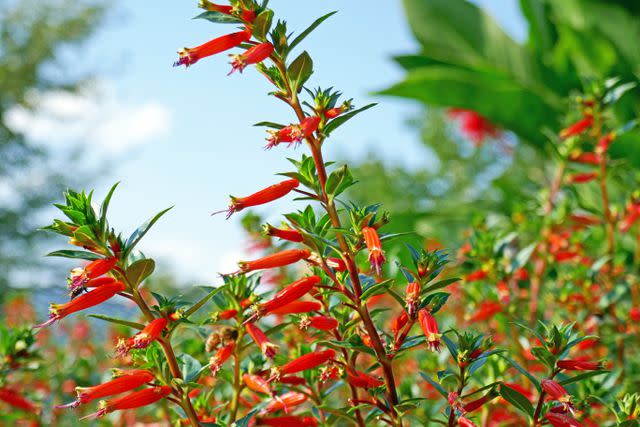
Getty Images
Botanical Name: Cuphea ignea
Sun Exposure: Full Sun
Soil Type: Medium Moisture, Well-draining, Average Fertility
Soil pH: Mildly Acidic to Neutral (6.0-7.8)
This hummingbird favorite makes a bold statement in the garden, with a profusion of tubular, fiery red-orange blooms that cover plants all season long. Plants are densely branched and develop a gorgeous, rounded form that looks great in gardens or containers. Glossy, dark green foliage adds to the display. Plants can be overwintered indoors in a sunny location.
Fan Flower
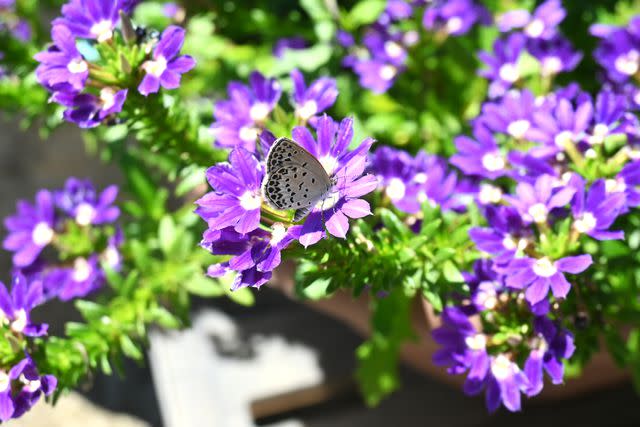
Getty Images
Botanical Name: Scaevola aemula
Sun Exposure: Full Sun to Part Shade
Soil Type: Medium Moisture, Well-draining, Average Fertility
Soil pH: Mildly Acidic to Neutral (6.0-7.5)
This aptly named plant produces an eye-catching display of lavender to dark blue fan-shaped flowers held in open, flat clusters. This bedding plant thrives in hot, dry climates and performs well in hanging baskets and containers as well as garden locations where it can sprawl. Plants bloom non-stop from early summer through frost.
Ornamental Peppers
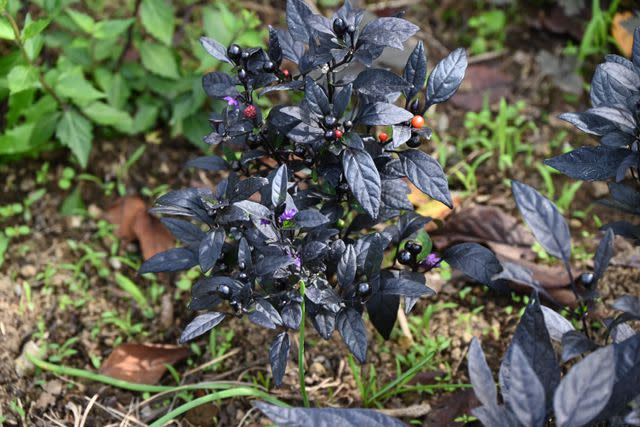
Getty Images
Botanical Name: Capsicum annuum
Sun Exposure: Full Sun
Soil Type: Moist, Well-draining, Rich
Soil pH: Acidic to Neutral (5.5-7.0)
Peppers are the ultimate sun-loving annual. They soak up those hot rays to produce vibrant, colorful, fruits that adorn the garden in fiery hues. Some ornamental peppers, such as 'Purple Flash' and 'Black Pearl', are grown as much for their colorful, dark purple foliage as for their fruits. Peppers are easy to grow and look stunning planted in mass.
Sunflower
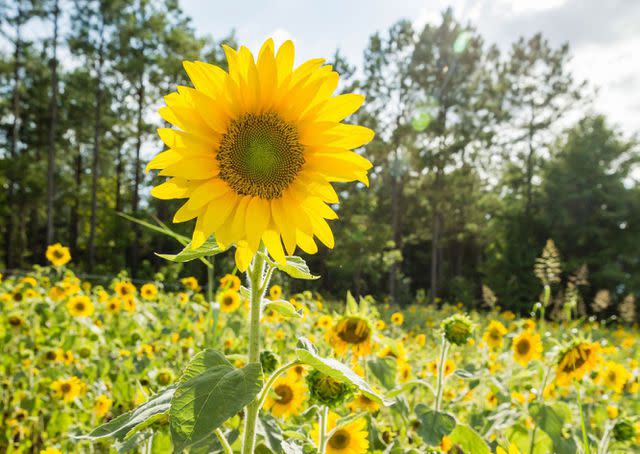
Robbie Caponetto
Botanical Name: Helianthus annuus
Sun Exposure: Full Sun
Soil Type: Dry to Medium, Well-draining, Average Fertility
Soil pH: Acidic to Neutral (5.5-7.8)
No sunny flower bed is complete without sunflowers! The quintessential easy-care annual produces over-sized blooms adored by birds, butterflies, and kids alike. Leave flower heads standing in winter to feed hungry songbirds or harvest seeds for a home-grown snack. Plants tolerate poor soil and dry sites.
Flowering Tobacco

Getty Images
Botanical Name: Nicotiana alata hybirds
Sun Exposure: Full Sun to Part Shade
Soil Type: Moist, Well-draining, Rich
Soil pH: Mildly Acidic to Neutral (6.1-7.8)
This classic flowering annual is tried and true, having graced gardens with fragrant blooms for generations. Flowering tobacco produces masses of tubular flowers that might bring to mind hummingbirds, but the blooms are actually pollinated by moths. While traditional flowering tobacco flowers open at night, most cultivars available at garden centers are day-blooming hybrids that produce non-fragrant blooms in shades of red, pink, lime-green, and white.
Plains Coreopsis
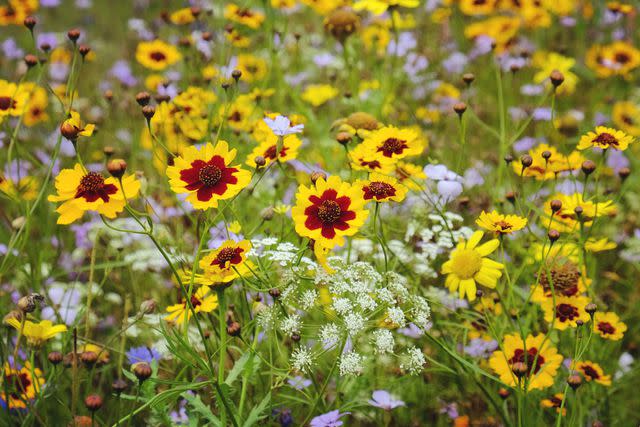
Getty Images
Botanical Name: Coreopsis tinctoria
Sun Exposure: Full Sun
Soil Type: Dry to Medium, Well-draining, Poor to Average Fertility
Soil pH: Mildly Acidic to Neutral (6.0-7.5)
Plains coreopsis is a rugged native annual perfect for those sunny, hard-to-water areas. Plants tolerate poor soils, sandy and rocky conditions, clay, and other challenging planting sites. And still, they flourish—offering masses of golden blooms with red to burgundy centers that attract native bees and butterflies. Songbirds feast on the seeds, which readily sow themselves in the garden.
For more Southern Living news, make sure to sign up for our newsletter!
Read the original article on Southern Living.

